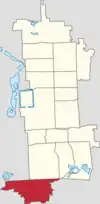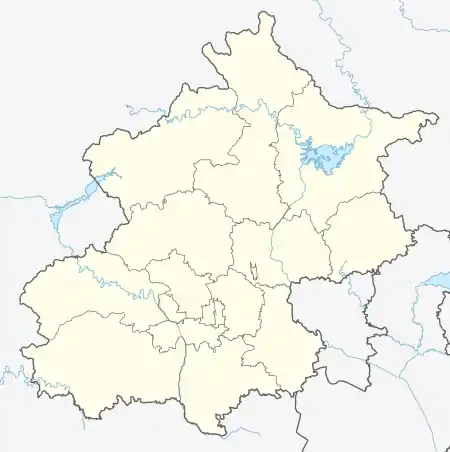Yongdingmenwai Subdistrict
永定门外街道 | |
|---|---|
.jpg.webp) Highspeed railway in the Yongdingmenwai subdistrict | |
 Location of Yongdingmenwai Subdistrict within Dongcheng District | |
 Yongdingmenwai Subdistrict  Yongdingmenwai Subdistrict | |
| Coordinates: 39°51′51″N 116°24′7″E / 39.86417°N 116.40194°E | |
| Country | China |
| Municipality | Beijing |
| District | Dongcheng |
| Area | |
| • Total | 3.33 km2 (1.29 sq mi) |
| Population (2020) | |
| • Total | 64,790 |
| • Density | 19,000/km2 (50,000/sq mi) |
| Time zone | UTC+8 (China Standard) |
| Postal code | 100075 |
| Area code | 010 |
Yongdingmenwai Subdistrict (Chinese: 永定门外街道; pinyin: Yǒngdìngménwài Jiēdào) is a subdistrict in the southern part of Dongcheng District, Beijing, China. By the year 2020, it has a population of 64,790.[1]
The subdistrict got its name from Yongdingmen (Chinese: 永定门; lit. 'Gate of Perpetual Peace'), a former front gate on the Beijing city wall.
History
| Year | Status |
|---|---|
| 1944 | Part of Yongwai Borough, Nanyuan District |
| 1952 | Part of Chongwen District. Two subdistricts were created: Yongdingmenwai and Liulijing. |
| 1955 | 12 surrounding villages and streets were incorporated |
| 1958 | 2 subdistricts merged into Yongdingmenwai Subdistrict |
Administrative Division
As of 2021, There are a total of 19 communities within the subdistrict:[3]
| Administrative Division Code | Community Name in English | Community Name in Chinese |
|---|---|---|
| 110101017001 | Pengzhuang | 彭庄 |
| 110101017002 | Zhonghai Ziyu | 中海紫御 |
| 110101017004 | Bairongjiayuan | 百荣嘉园 |
| 110101017005 | Guancun | 管村 |
| 110101017006 | Taoyuan | 桃园 |
| 110101017007 | Minzhubeijie | 民主北街 |
| 110101017008 | Liulijing | 琉璃井 |
| 110101017009 | Yangtaolu | 桃杨路 |
| 110101017010 | Yangjiayuan | 杨家园 |
| 110101017011 | Licun | 李村 |
| 110101017012 | Baohuali | 宝华里 |
| 110101017013 | Ding'anli | 定安里 |
| 110101017014 | Anlelin | 安乐林 |
| 110101017015 | Jingtai | 景泰 |
| 110101017016 | Yongtieyuan | 永铁苑 |
| 110101017017 | Tiantian Jiayuan | 天天家园 |
| 110101017018 | Fulaiyin | 富莱茵 |
| 110101017019 | Gexinxili | 革新西里 |
| 110101017020 | Gexinli | 革新里 |
Landmarks
External links
References
- ↑ Zhong guo tong ji nian jian = China statistical yearbook. 2020(zong di 39 qi) 2020(No. 39). Guo jia tong ji ju, 国家统计局. (Di 1 ban ed.). Beijing: Zhong guo tong ji chu ban she. 2020. ISBN 978-7-5037-9225-0. OCLC 1262741013.
{{cite book}}: CS1 maint: others (link) - ↑ Zhong hua ren min gong he guo zheng qu da dian. Bei jing shi juan. Li li guo, Li wan jun, Wu shi min, 李立国., 李万钧., 吴世民. Bei jing: Zhong guo she hui chu ban she. 2013. ISBN 978-7-5087-4058-4. OCLC 910451741.
{{cite book}}: CS1 maint: others (link) - ↑ "2021年统计用区划代码和城乡划分代码". www.stats.gov.cn. Retrieved 2022-09-18.
This article is issued from Wikipedia. The text is licensed under Creative Commons - Attribution - Sharealike. Additional terms may apply for the media files.